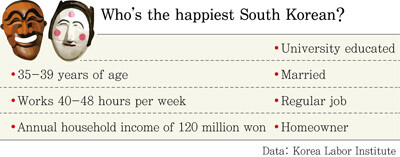hankyoreh
Links to other country sites 다른 나라 사이트 링크
Survey finds that to be happy, South Koreans need to have work

Until their late 30s, South Koreans get happier with age, but starting at age 40, this trend reverses, a new study finds. Happiness also increases with income, but this stops after a certain point.
This analysis of South Koreans’ happiness appeared in a report titled “Work and Happiness (I),” published in Monthly Labor Review on May 6. The report was prepared by researchers at the Korea Labor Institute, the Korea Institute for Industrial Economics and Trade and the Korean Women’s Development Institute.
Drawing upon data from a 2014 labor panel study of 5,000 South Korean households, the report factored in demographic characteristics (sex, age, education and marriage), household income, employment status and job characteristics (wage level, working hours and employment type) to measure happiness on a five-point scale.
Conflicting with the conventional wisdom that women are happier than men, there was little difference between men (3.43) and women (3.42) in this study. Happiness rose along with education level, but this was presumably because wages are determined by education.
Individuals who had not married or who were divorced, separated or bereaved were less happy than those who had married and were still with their spouse. Men without spouses were particularly unhappy, and divorced men were the unhappiest of all.
Happiness increased along with total household income, but this peaked at 3.79 with a yearly income of 120 million won (US$103,000) and then fell again. Of people in households earning between 108 and 120 million won a year, 78% said they were happy and less than 1% said they were unhappy. In contrast, just 23% of those in households earning less than 12 million won a year said they were happy, while 14% said they were unhappy.
Overall, people with jobs were happier than people without jobs. But among wage workers, there were clear differences in degree of happiness between full-time workers, temporary workers, and day laborers. Among men, the unemployed were distinctly less happy, but among women, the unemployed were actually happier than temporary workers and day laborers.
Considering employment types, irregular workers were not as happy as regular workers, and they were particularly unhappy when they had not voluntarily chosen to be irregular workers. The level of happiness was also lower among those who said they did not have stable employment.
Women who had to balance a job and a family were more sensitive about their working hours. The level of happiness fell as working hours increased, with men feeling happiest at 47.6 hours and women at 32.2 hours [a week]. Individuals were also less happy when their working hours varied with the season.
By Jeong Eun-joo, staff reporter
Please direct questions or comments to [english@hani.co.kr]

Editorial・opinion
![[Column] Park Geun-hye déjà vu in Yoon Suk-yeol [Column] Park Geun-hye déjà vu in Yoon Suk-yeol](https://flexible.img.hani.co.kr/flexible/normal/500/300/imgdb/original/2024/0424/651713945113788.jpg) [Column] Park Geun-hye déjà vu in Yoon Suk-yeol
[Column] Park Geun-hye déjà vu in Yoon Suk-yeol![[Editorial] New weight of N. Korea’s nuclear threats makes dialogue all the more urgent [Editorial] New weight of N. Korea’s nuclear threats makes dialogue all the more urgent](https://flexible.img.hani.co.kr/flexible/normal/500/300/imgdb/original/2024/0424/7317139454662664.jpg) [Editorial] New weight of N. Korea’s nuclear threats makes dialogue all the more urgent
[Editorial] New weight of N. Korea’s nuclear threats makes dialogue all the more urgent- [Guest essay] The real reason Korea’s new right wants to dub Rhee a founding father
- [Column] ‘Choson’: Is it time we start referring to N. Korea in its own terms?
- [Editorial] Japan’s rewriting of history with Korea has gone too far
- [Column] The president’s questionable capacity for dialogue
- [Column] Are chaebol firms just pizza pies for families to divvy up as they please?
- [Column] Has Korea, too, crossed the Rubicon on China?
- [Correspondent’s column] In Japan’s alliance with US, echoes of its past alliances with UK
- [Editorial] Does Yoon think the Korean public is wrong?
Most viewed articles
- 1‘We must say no’: Seoul defense chief on Korean, USFK involvement in hypothetical Taiwan crisis
- 2N. Korean delegation’s trip to Iran shows how Pyongyang is leveraging ties with Moscow
- 3‘Weddingflation’ breaks the bank for Korean couples-to-be
- 4[Column] Park Geun-hye déjà vu in Yoon Suk-yeol
- 5Korea sees more deaths than births for 52nd consecutive month in February
- 6[Guest essay] The real reason Korea’s new right wants to dub Rhee a founding father
- 7[Column] The clock is ticking for Korea’s first lady
- 8[Column] Has Korea, too, crossed the Rubicon on China?
- 9Why Korea shouldn’t welcome Japan’s newly beefed up defense cooperation with US
- 10Will NewJeans end up collateral damage in internal feud at K-pop juggernaut Hybe?